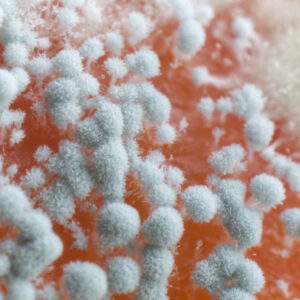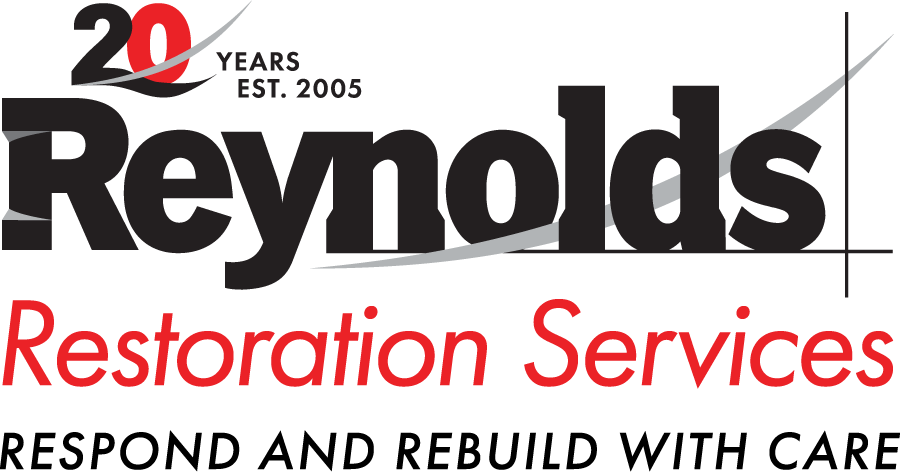
White mold looks white and powdery and can appear on many different types of surfaces. White mold is often confused with efflorescence. Efflorescence is a salt deposit that forms on brick, concrete, stone, stucco or other surfaces when moisture dries. If you are unsure if you have white mold or efflorescence, efflorescence will dissolve in water, and white mold will not.
While white mold doesn’t get the same attention as black mold, it can still be problematic for a home or business owner. Let’s examine what causes white mold, what makes it dangerous, and how you can remove a small white mold problem at your home or business.
Causes of White Mold
Mold needs two main things to grow and thrive – water and a food source. It can grow almost anywhere, but because basements and bathrooms tend to have more moisture than other areas of a home or building, mold often starts in those rooms.
Mold can also start to grow in hidden areas, such as behind drywall or beneath carpeting. Once mold starts to grow, it can quickly spread to other areas of a structure.
While there are many causes of a mold infestation, here are some of the most common:
- High humidity: Mold loves humidity. When humidity levels rise over 55%, homeowners and business owners may start to see signs of mold growth. To prevent mold, use a dehumidifier in damp space.
- Leaky pipes: Leaking pipes, especially in a basement or bathroom, can create extra moisture. This moisture helps mold to grow. Check your pipes frequently for leaks to prevent mold from forming.
- Roof leaks: Like leaking pipes, roof leaks can cause mold to start to grow in a building, especially an attic. Because attic insulation is a good food source for mold, mold will spread quickly once it starts to grow.
- Faulty air conditioners: Leaking or faulty air conditioners are often causes of mold growth. Air conditioners create moisture to cool down a room, and when functioning improperly, that moisture can feed mold.
- Flooding: After a flood, one of the biggest risks for further damage to a home is mold growth. Homes and offices can take days, sometimes even weeks, to dry out. Before the structure is completely dry, mold can start to form. If you have a flood at your home or office, your best path to staying ahead of mold growth is to contact a restoration professional.
Is White Mold Dangerous?
All types of mold can be problematic, including white mold. It can cause health problems for building occupants, and if left untreated, can cause structural damage.
Since white mold is often unnoticed, people living in a home infected with white mold can slowly start to experience health problems. Excessive white mold growth can lead to health problems including:
- Allergic reactions: Many people are allergic to mold, and once exposed, can experience an allergic reaction. Symptoms include difficulty breathing, coughing, rashes, and skin irritation.
- Respiratory infections: For people with a compromised immune system, mold can cause a respiratory infection. If the mold is not remediated, the infection may reoccur after medical treatment.
- Eye irritation: Even if someone isn’t diagnosed with a mold allergy, mold can still cause eye irritation. Eye irritation is one of the most common symptoms of mold exposure. Since the eye is sensitive to irritants, it can be easily affected by mold and mildew.
- Headaches: Headaches are another common complaint among people exposed to mold. Because the mold spores affect the respiratory system, it can affect the sinuses and cause headaches.
- Dizziness: Mold contains chemicals and mycotoxins that can affect the nervous system and cause dizziness or vertigo.
- Nausea: While not as common as other symptoms, the mycotoxins in mold can cause nausea, vomiting, and digestive issues.
- Depression: Several studies show a correlation between mold exposure and depression. The toxins in mold can affect the frontal cortex of the brain leading to anxiety and depression.
Different species of mold are more dangerous than others, but all mold can cause issues. If you’ve found mold in your home or office, it’s important to take quick action to prevent health issues.
Learn About Our Mold Remediation Restoration Services
Can I Remove White Mold?
If you’ve found white mold growing in your home, it’s best to address the affected area as soon as possible. For small mold outbreaks, you may be able to remove the mold yourself, although it is quite an undertaking. Because mold can cause health issues, you will want to take precautions to protect yourself and others in your home or office.
For safe mold removal, follow these steps:
- Wear personal protective equipment (PPE): Before attempting to remove white mold, and especially black mold, put on protective gear including gloves, a mask, and goggles. PPE can help you stay safe from toxins.
- Throw out contaminated items and belongings: Some materials such as paper, moldy carpeting, cardboard, and other porous items can not be saved after they are affected by mold. Safely remove and discard these items.
- Open windows and doors: Because mold grows quickly in damp, poorly ventilated areas, open the windows and doors in the affected room. This air movement will help dry out the area. At Reynolds Restoration Services, we use commercial desiccant dehumidifiers for this same purpose.
- Don’t cover it, remove it: Paint and caulk will only camouflage a mold issue, rather than remove it. When you cover up mold with something else, the mold doesn’t disappear and can still cause problems.
For mold issues that are spreading quickly, or if you don’t have the proper supplies or equipment, a professional mold remediation company can take care of the mold for you.
Mold Remediation Specialists
For more than 15 years, Reynolds Restoration Services has been helping home and business owners tackle white mold problems quickly, safely, and efficiently. Our team uses commercial-grade mold removal products that are non-toxic and safe for homeowners and their families (including pets), and employees and commercial building occupants.
Our approach to mold removal includes:
- Wipe and sanitize all surfaces using a non-toxic EPA approved product
- Clean fabrics with a HepaVAC. HepaVACs are different from a regular home-use vacuum and contain filters to trap and remove small particles like white mold spores.
- “Scrub” air to remove mold spores using an air scrubber, a portable filtration system that removes particles and mold from the air.
If you’ve discovered a mold issue at your home or office, reach out to us today to start the mold remediation process. With offices to serve you in Harrisburg, Pa., King of Prussia, Pa., and the Baltimore, Md./DC metro region, we can be on-site quickly.

President of Reynolds Restoration Services. Over 20 years of experience in the emergency restoration industry.

